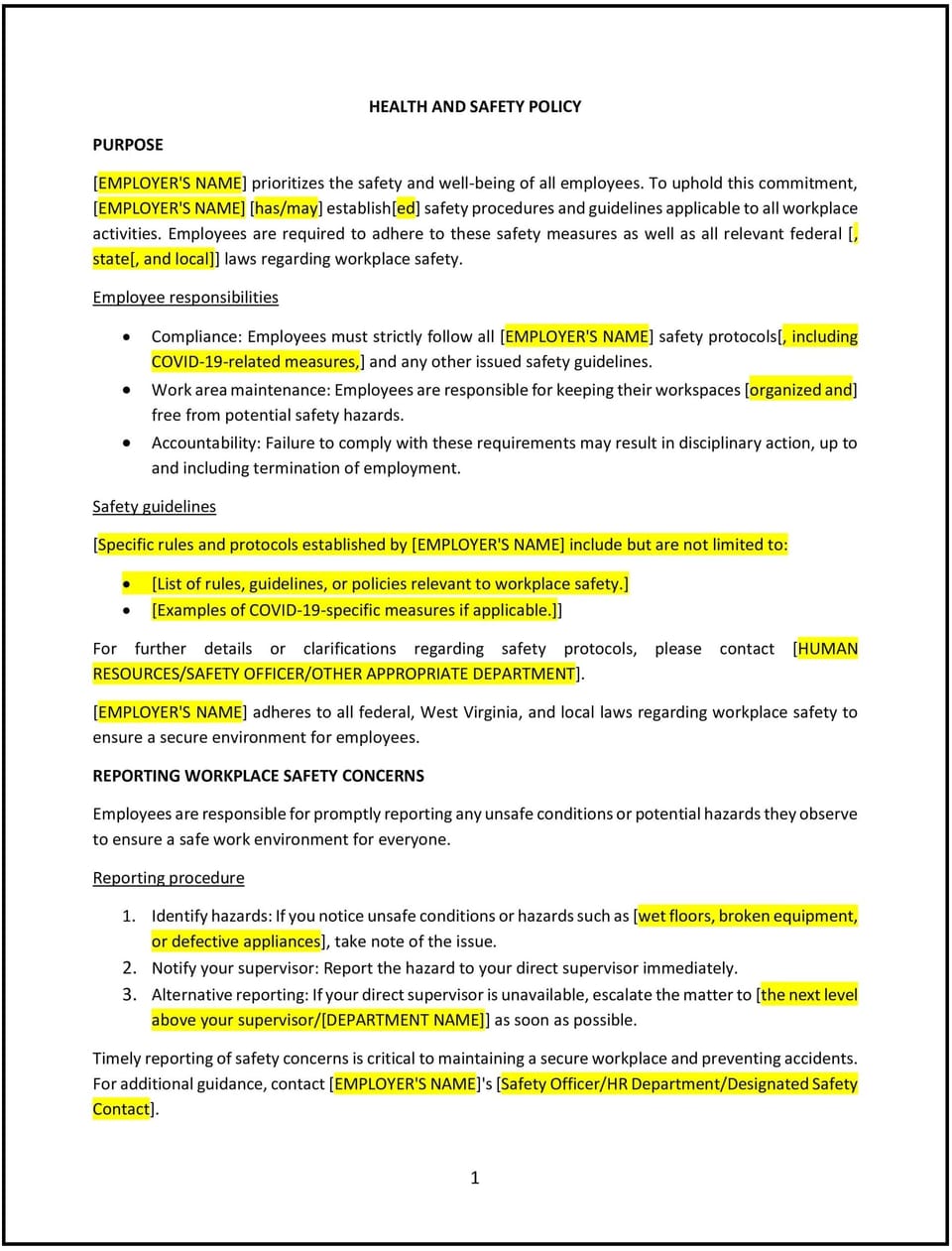Health and safety policy (West Virginia): Free template

Health and safety policy (West Virginia)
In West Virginia, a health and safety policy provides guidelines to maintain a safe and healthy workplace for employees, customers, and visitors. This policy supports compliance with state and federal laws, such as OSHA regulations, and outlines the organization’s commitment to identifying, managing, and mitigating workplace hazards.
The policy establishes roles and responsibilities, preventive measures, and procedures for responding to health and safety incidents.
How to use this health and safety policy (West Virginia)
- Define safety standards: Clearly specify safety practices, such as maintaining clean workspaces, proper use of equipment, and adherence to safety protocols.
- Assign responsibilities: Outline the roles of employees, supervisors, and management in promoting workplace safety and addressing potential hazards.
- Implement preventive measures: Include strategies like regular safety inspections, training programs, and risk assessments to identify and mitigate risks.
- Establish reporting procedures: Provide employees with clear steps to report hazards, injuries, or unsafe conditions, including contact points and documentation requirements.
- Support compliance: Align the policy with West Virginia safety regulations and OSHA standards to ensure adherence to legal requirements.
Benefits of using a health and safety policy (West Virginia)
- Enhances safety: Reduces the risk of workplace accidents, injuries, and illnesses by promoting safe practices and identifying hazards.
- Supports compliance: Aligns with West Virginia labor laws and OSHA regulations to help businesses meet safety standards and avoid penalties.
- Improves morale: Demonstrates the company’s commitment to employee well-being, fostering trust and engagement.
- Encourages accountability: Establishes clear expectations for maintaining a safe workplace and reporting hazards.
- Reduces liability: Protects the organization from potential legal claims by addressing safety risks proactively.
Tips for using a health and safety policy (West Virginia)
- Communicate the policy: Share the policy with all employees during onboarding and ensure it is accessible for reference.
- Provide regular training: Offer safety training programs tailored to the organization’s specific risks and workplace hazards.
- Conduct inspections: Perform regular workplace inspections to identify and address hazards promptly.
- Document incidents: Maintain detailed records of workplace incidents, corrective actions, and any improvements made to safety protocols.
- Review periodically: Update the policy to reflect changes in West Virginia laws, workplace practices, or industry standards.
Q: What safety practices are outlined in this policy?
A: The policy covers practices such as maintaining clean workspaces, using personal protective equipment (PPE), and following safety protocols specific to the organization’s industry.
Q: How can employees report workplace hazards?
A: Employees can report hazards or unsafe conditions to their supervisor, HR, or a designated safety officer. The policy provides specific reporting procedures.
Q: Does this policy align with OSHA standards?
A: Yes, the policy aligns with OSHA standards and West Virginia safety regulations to promote compliance and workplace safety.
Q: How often should safety training be conducted?
A: Safety training should be conducted regularly, such as during onboarding, annually, or when introducing new equipment or procedures.
Q: How does this policy benefit West Virginia businesses?
A: The policy enhances safety, reduces legal risks, and supports compliance, creating a secure work environment and improving employee morale.
This article contains general legal information and does not contain legal advice. Cobrief is not a law firm or a substitute for an attorney or law firm. The law is complex and changes often. For legal advice, please ask a lawyer.


